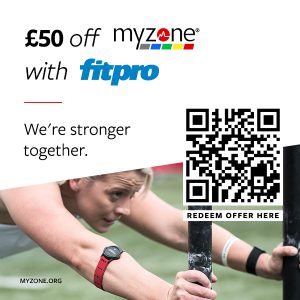Adam Daniel shares three reasons why you should integrate heart rate technology into your coaching for better client results.
1. HR training can make group fitness more personal
Group training sessions are attractive to many people because there’s a belief that we are all in this together – a sense of camaraderie. Yet, often when working with groups, there can be a sense of a ‘one size fits all approach’ (ie there is no personal touch and no option to make changes based on the person’s needs at that moment in time).
HR monitors help coaches measure members’ physical, metabolic and psychological state during the session. By gaining an insight into any of these areas on a regular basis, you will know when it’s appropriate to push a person more or ask them to dial it back a bit. By gathering this data, the coach can make decisions based on each client’s individual needs in real time, leading to more individual and effective workouts for each and every member, giving them an amazing experience and making it much more likely they’ll achieve their goals.
Many boutique gyms (think David Lloyd and Blaze) are taking this concept mainstream by offering members HR monitors (Myzone). Coaches can monitor intensity and give tailored advice during classes. Members can download an app to see their performance stats and set goals. It’s this combination of data and personal coaching that differentiates the boutique from the traditional group exercise class.
2. HR monitors can make health goals more attainable through accountability
For all your clients and members wanting to hit their goals, there are (hopefully) smaller monthly, weekly and maybe even daily actions to achieve that bigger goal, with metrics to measure and track progress. As coaches, we can help clients/members identify at least one metric to move them towards their monthly, weekly or daily actions; for example, spend 10 minutes at 80-90% of their maximum HR in each training session or drop their recovery HR by 10 beats in 60 seconds through diaphragmatic breathing at the end of their sessions – you get the idea. Using these metrics makes the bigger goal more achievable because they can see themselves moving forwards and, if they find themselves at a plateau (which happens), we as coaches can see what the data is telling us and make the necessary changes.
Using HR tracking also increases accountability because there is now ‘nowhere to hide’, meaning that if the coach asks the person/group to work at an RPE of seven out of 10, then this is the perceived effort of the individual and, in reality, is very subjective (I’m sure most coaches have asked a member their RPE to be told eight, when they are obviously a five or six, yet without ‘proof’ you are unable to challenge this safely), whereas if the coach says work to 70-75% of the maximum HR, there are two options – you do or you don’t – and this now becomes a choice and is objective. This is where you see real change: when clients realise how hard they have to work to achieve change, they have to decide if they are in or out, and either option is OK, as long as everyone is aware.
3. Wearables can help minimise overtraining and injury risk
The aim of training is to apply stress to the body so that it will adapt, recover, get stronger and get better. The more information the coach has to understand whether the stress you’re putting on a client is too much or not enough (in endurance sport this is called the training stress score or TSS), the more of an informed decision the coach can make to help them train harder and recover better.
When it comes to preventing injuries, aches and pains, which are common causes for clients falling short of their goals, HR data is especially helpful for identifying any trends (e.g., overtraining because different metrics can be tracked, allowing stress and fatigue to be monitored and therefore reducing the number or frequency of their aches, pains and injuries).
So, whether it’s to improve a 10km time, lose a few kilos of fat, gain a few kilos of muscle or simply wanting to be more active and decrease stress levels, HR monitors and the data they provide can help clients overcome any challenges that may stand in their way of success.
One thing that’s clear: HR monitor technology isn’t going anywhere and it’s only going to get more accurate (although chest-based straps are already 99.4% as accurate as an ECG) and measure more things.
Rather than thinking in terms of coaches versus tech, let’s as coaches embrace technology and use it to help more people achieve their goals.
Want to save £50 off Myzone heart rate monitors? Simply use the QR code below or click here!

Author Bio:

Adam Daniel is an accomplished sportsman, fitness entrepreneur and a Performance and Personal Impact Coach with an innate desire to see individuals, teams and businesses truly thrive.
He has developed and delivered educational programmes for some of the world’s leading fitness brands, coached fitness professionals and industry leaders in over 20 countries and has led the educational teams for some of the most prestigious fitness industry names as well as worked with the English RFU and British Rowing.
Adam attained an MBA in International Sports Management in 2016 and is currently completing an MSc in Coaching and Behaviour Change.
Over the last 2 years Adam has worked with and is working with some of the world’s largest organisations such as Accenture, ARUP, Thomson Reuters, ASOS, AIG and the Welsh Rugby Union delivering workshops and coaching on resiliency, leadership and strategy.
He has successfully coached a vast array of clients including royalty, senior business leaders, pop stars, supermodels and professional athletes (amassing over 22,000 one to one coaching hours).







